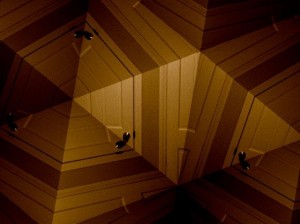Inspiring Interior Design (Part 6)
By Asher Crispe: August 13, 2012: Category Inspirations, Quilt of Translations
Room to Room
On the most basic level, the study of Kabbalah is about perceiving parallels and reflecting upon systems of correspondence (Kabbalah originally comes from hak’balah meaning ‘parallel’ or correspondence). In our last article, we demonstrated how the six archetypal rooms of an ideal house are homologous with the six elementary emotive spheres. Now, we will attempt to go a step further and show how multivalent of relationships between the rooms are.
Our first step consists of evaluating the datum of six rooms and trying to determine if any compression algorithm can reduce their number. Since three of the rooms (girl’s, boy’s and parents) all serve as bedrooms, we can generalize the bedroom as having a single and essential role within the workings of the home. For our home to be a home, we do require bedroom space or spaces–just in the expanded model of six rooms we provided a more comprehensive view of its integral modalities and thus featured three distinct kinds of bedroom.
While we can always choose whether or not to work in the direction of greater complexification or greater simplification, for now will we follow the latter. Consequently, in the ‘broadest’ terms, ‘outside the home’ contrasts with ‘inside the home’ as an affirmation of the rabbinic distinction between public (reshut ha’rabim) and private (reshut ha-yachid) domains. However, the cloth of Talmudic thought is often pleated and the sages cannot resist turning the opposition of a ‘two-fold’ distinction into a four-fold one (as in the often cited expression ‘two which are four’ [sh’taim shehem arba] that essentially recapitulates both domains within both domains). Juxtaposing the relatively public domain of the living room, kitchen, and dining room areas with the private domain of the bedrooms, we can get a sense of how both the public and private are reiterated within the private.
Once assigned a singular status, the bedroom (along with the living room, kitchen, and dining room) completes a new picture of our house of God (Havayah) as one of four rooms. As a bayit (house) for the letters Yud-Hei-Vav-Hei, it follows that each room will have a one-to-one correspondence with one of these modes of Being (remember: Havayah means ‘Being’ or ‘Reality’). Each link of room to letter in this Divine name reveals something new and will enhance our meditation on the nature of interior design. This being said, we can use different taxonomic systems or alternative logic gates for generating the ‘labels’ that identify these relationships.
For the time being, we will provide only two possible schemas–both of which attest to the division of the four into a grouping of three and one (Note: the second of these will be fully dealt with in Part Seven). Grammatically speaking, this is the most common construction of a word in Hebrew with the three letter root of a word undergoing modifications by means of the fourth letter. The Tetragrammaton itself exhibits this structure.
If we make our cut after the first three letters, Yud-Hei-Vav, and before the final Hei, it would make good sense in that the final Hei is a repeated letter. The logical distinction would be a division between non-repetitious and repetitious elements. At the same time, we could justify picking the letter Yud and the mark of difference. The Yud grammatically changes the other three letters which spell the word hoveh meaning the ‘present’ on their own, into an active state of hit’havut which means ‘to bring into being.’ The implication is that what is here is not all ‘present.’ Rather, we are experiencing that which is ‘not-yet’– the continual bringing ‘into being of existence.’
Weighing the associations we have of the life of each of our rooms (once again on a relative scale), it becomes clear that the bedroom gets cast in the role of the future provider. First among the bedrooms, the parent’s room ‘houses’ the performance of procreation. Futurity by way of progeny (who will themselves occupy the other bedrooms as the next generation) implies that all is not yet present and accounted for in our house. Just as the Yud denotes the regenerative quality of Being or Reality reserving (semiotic) space for a future ‘to Be’ so too, the parent’s bedroom serves as the placeholder for what kabbalists refer to as an experience of chochmah or insight (itself correlating with the letter Yud throughout kabbalistic literature).
Insight implies interiority and privacy. Moreover, as we have addressed elsewhere, ‘continually creative’ insight is offered to those who are modest as in Proverbs 11:2 “with modesty comes insight (chochmah).” In light of these, we can reemphasize how our home should have a large living room, sharp kitchen, beautiful dining room and now, a private (modest) bedroom.
For the more advanced student of Kabbalah, the connection between the four letters of the name Havayah and the four worlds (Emanation, Creation, Formation and Action) adds another dimension to this relationship. The highest of these worlds is called the world of Atzilut (Emanation). Of its descriptions, we find that it is depicted as a world that is exclusively conscious of Divinity. It is the domain of the One (unity) or literally the reshut ha’yachid (private domain or the domain of the singular) in contrast to the other three worlds which introduce varying degrees of multiplicity into our conscious and hence bear the name reshut ha’rabim (public domain: literally the domain of the multiple). Being continuously and completely connected to the consciousness of Divinity is likened by the mystics to a state of conjunction (zivug or yichud), a creative connection and a marriage of the finite and infinite. As a result, this highest world and its attendant transcendental consciousness, also bears the name olam ha’zivugim meaning the ‘world of unifications.’ All of the features of this world cross-fertilize one another.
Given these features of the world of Emanation, we can better understand why the sages inform us that the Torah itself derives from the experience of insight (d’oraita m’chochmah nafkat). Furthermore, the word Torah itself is a cognate of the word hora’ah meaning ‘instruction.’ One of the reasons for this is that the Torah is not merely for the sake intellectual curiosity but is intended to by instructive in our lives. This same root, however, also builds the word horim which means ‘parents.’ Often, in Kabbalah and Chassidut, one’s metaphysical parents are the Written Torah (father) and Oral Torah (mother). The parent’s bedroom then becomes a place for the creative union that will in turn engender Torah scholarship and Torah scholars.
Finally, tying back in to our earlier mapping of the rooms in terms of six emotive spheres, the parent’s bedroom was then equated with the quality of yesod or ‘foundation’ which was explained as the soul power of self-actualization that is embodied in the procreative organs. When the kabbalists look at this word, they break it apart and often read it as Yud-sod [י-סוד] which translates as Yud (the letter which graphically looks like a ‘seed’) is the secret (sod). In other words, that which issues from the procreative organs has its origins in the ‘mind’ of the ‘father’ (as explained in classic works of Chassidic philosophy such as the Tanya). Insight or chochmah is also called the mentality of father (mochin d’abba) in the Zohar. Without elaborating on this subject fully, we can merely say that our outer creative drives originate deep within us in the innermost privacy of our own home (body / bedroom). An implicit conduit leads directly from chochmah to yesod.
The next three rooms also display entangled relationships. As public domains, they relate to the three lower worlds of Creation, Formation and Action. The world of Creation or Beriyah presents us with the raw materials of the world. Corresponding to the first Hei in the name Havayah, the kitchen in our present model acts upon a world that is as of yet unfinished and unformed. All we have is an indefinite ‘something.’ Unmediated experience requires cooking. The processing of reality at this level equates with the processes of food preparation. Washing, cutting up, mixing, molding and baking (to name but a few methods) remediate our amorphous sustenance and hopefully aid in its appeal and digestion.
Cognitively, the kitchen of the mind is the left brain whose representational thinking and cooked concepts ‘kill’ the pure harvest from the field of perception. In Kabbalah this is called mochin d’emma or the ‘mentality of mother.’ ‘Mother’ here is like a transformer or ‘central processing unit’ cooking all of our experience within our conceptual vessels. To ‘conceive’ of ‘something’ requires this ‘matrix’ (mother) of representation.
Then comes the eating. Without a doubt the most famous eating reference in the Torah involves the eating from the Tree of Knowledge. As we explained earlier, da’at (knowledge) may be likened to eating–the final internalization and subjective registering of a thought process. Once more, our six emotive spheres are all ‘opened’ by this eating or integration of new knowledge. From the preparation in the kitchen of mother (not that mother is in the kitchen but that the kitchen is the ‘mother’ figure of the mind), our food is served to us in the dining room.
Consuming a new state of consciousness (also from da’at) and, at times, being consumed by it, triggers all sorts of emotions. We might suggest that there then be six place settings around the ideal table in the dining room if we continue to extend this line of reasoning. These six are now the ‘seats’ of our emotions (the Vav in the name Havayah as well as the world of Yetzirah or Formation) that are ‘fed’ by a newly fashioned mind-meal.
With three accounted for, we are only left with the living room. There is life as it is experienced (‘taking it all in’) and then there is life as it is expressed (‘letting it all out’). From my inner subjective world, I must go out of my interior experience and encounter others, interact and straddle the membrane of self. The primary porting of the world at large into the home happens in the living room (‘bringing the whole world into your living room’ via television and radio for instance). Entertaining our guests, too, can be raised to the level of diplomacy bridging private and public affairs. We might even say that a person ‘holds court’ in his or her own home. Mastery within ones own home begins to affect the home’s inhabitants and guests who are provisionally transformed into one’s ‘subjects’ within the walls of the living room. The living room therefore relates to the final Hei which relates both to the world of Asiyah (Action) and the sphere of Malchut or Kingdom (one’s domain of influence in life).
Our exploration of variations in room assignments and additional home features will be continued in Part Seven.
http://www.interinclusion.org/inspirations/inspiring-interior-design-part-7/

























;)
;)
;)
;)
;)
;)
;)
;)
;)
;)
